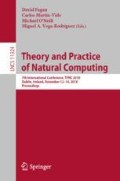Abstract
The emergence of new annealing hardware in the last decade and its potential for efficiently solving NP hard problems in quadratically unconstrained binary optimization (QUBO) by emulating the ground state search of an Ising model are likely to become an important paradigm in natural computing. Driven by the need to parsimoniously exploit the limited hardware resources of present day and near-term annealers, we present a heuristic for constructing graph minors by means of simulated annealing. We demonstrate that our algorithm improves on state of the art hardware embeddings, allowing for the representation of certain QUBO problems with up to 50% more binary variables.
Access this chapter
Tax calculation will be finalised at checkout
Purchases are for personal use only
Notes
- 1.
- 2.
We create random graphs by growing a tree up to the desired number of vertices. To this end we add one vertex at a time and connect it to one of the existing vertices with equal probability. Subsequently, we add edges to the tree, by filling unoccupied edges with equal probability until the prescribed edge density is reached.
References
Adler, I., et al.: Faster parameterized algorithms for minor containment. Theoret. Comput. Sci. 412(50), 7018–7028 (2011)
Cai, J., Macready, B., Roy, A.: A practical heuristic for finding graph minors, arxiv:1406.2741
Choi, V.: Minor-embedding in adiabatic quantum computation: I. the parameter setting problem. Quant. Inf. Process. 7(5), 193–209 (2008)
Choi, V.: Minor-embedding in adiabatic quantum computation: II. minor-universal graph design. Quant. Inf. Process. 10(3), 343–353 (2011)
Farhi, E., et al.: A quantum adiabatic evolution algorithm applied to random instances of an NP-complete problem. Science 292(5516), 472–475 (2001)
Inagaki, T., et al.: A coherent Ising machine for 2000-node optimization problems. Science 354(6312), 603–606 (2016). https://doi.org/10.1126/science.aah4243
Isakov, S., et al.: Optimised simulated annealing for Ising spin glasses. Comput. Phys. Commun. 192, 265–271 (2015)
Johnson, M.W., et al.: Quantum annealing with manufactured spins. Nature 473, 194–198 (2011)
Kadowaki, T., Nishimori, H.: Quantum annealing in the transverse Ising model. Phys. Rev. E 58, 5355–5363 (1998)
Kirkpatrick, S., Gelatt, C.D., Vecchi, M.P.: Optimization by simulated annealing. Science 220(4598), 671–680 (1983)
Klymko, C., Sullivan, B.D., Humble, T.S.: Adiabatic quantum programming: minor embedding with hard faults. Quant. Inf. Process. 13(3), 709–729 (2014)
Kochenberger, G., et al.: The unconstrained binary quadratic programming problem: a survey. J. Comb. Optim. 28(1), 58–81 (2014)
Lucas, A.: Ising formulations of many NP problems. Front. Phys. 2, 5 (2014)
McMahon, P.L., et al.: A fully programmable 100-spin coherent Ising machine with all-to-all connections. Science 354(6312), 614–617 (2016)
Okuyama, T., et al.: Contractive graph-minor embedding for CMOS Ising computer. IEICE Tech. Rep. 116, 97–103 (2016)
Okuyama, T., Hayashi, M., Yamaoka, M.: An Ising computer based on simulated quantum annealing by path integral Monte Carlo method. In: 2017 IEEE International Conference on Rebooting Computing (ICRC), pp. 1–6 (2017)
Shahriari, B., et al.: Taking the human out of the loop: a review of bayesian optimization. Proc. IEEE 104(1), 148–175 (2016)
Yamaoka, M., et al.: A 20k-spin Ising chip to solve combinatorial optimization problems with CMOS annealing. IEEE J. Solid-State Circ. 51(1), 303–309 (2016)
Zhu, Z., Ochoa, A.J., Katzgraber, H.G.: Efficient cluster algorithm for spin glasses in any space dimension. Phys. Rev. Lett. 115, 077201 (2015)
See publications in technology section on the homepage of D-Wave Systems Inc. Accessed 20 July 2018. https://www.dwavesys.com/
Acknowledgements
It is our pleasure to thank Hirofumi Suzuki, Kazuhiro Kurita, and Shoya Takahashi for supporting the organization of the “Hokkaido University & Hitachi 2nd New-Concept Computing Contest 2017.”
Author information
Authors and Affiliations
Corresponding author
Editor information
Editors and Affiliations
Rights and permissions
Copyright information
© 2018 Springer Nature Switzerland AG
About this paper
Cite this paper
Sugie, Y. et al. (2018). Graph Minors from Simulated Annealing for Annealing Machines with Sparse Connectivity. In: Fagan, D., Martín-Vide, C., O'Neill, M., Vega-Rodríguez, M.A. (eds) Theory and Practice of Natural Computing. TPNC 2018. Lecture Notes in Computer Science(), vol 11324. Springer, Cham. https://doi.org/10.1007/978-3-030-04070-3_9
Download citation
DOI: https://doi.org/10.1007/978-3-030-04070-3_9
Published:
Publisher Name: Springer, Cham
Print ISBN: 978-3-030-04069-7
Online ISBN: 978-3-030-04070-3
eBook Packages: Computer ScienceComputer Science (R0)

